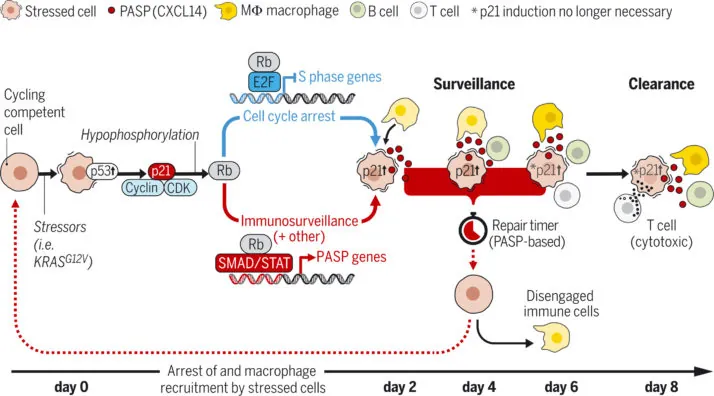Researchers publishing in Science have found that the well-known biomarker p21 starts a fatal timer for mouse liver cells.
Get better or die
As the researchers demonstrate, the cyclin-dependent kinase inhibitor p21, which is encoded by the Cdkn1a gene, is associated with its own secretome: the p21-associated secretory phenotype (PASP). Similar but not identical to the senescent-associated secretory phenotype (SASP), the PASP consists of hundreds of factors.
The most prominent of these factors is the chemokine CXCL14. This compound attracts macrophages to the area, placing the stressed cells under immunosurveillance. While the macrophages remain nearby, they do not directly interfere with the cells. Rather, these immune cells hang around the area, and it can be presumed that these cells would attempt to deal with local stressors that are harming the cells, but these guards also have another, more morbid, function.
If the stressed cells continue to express p21 after a period of four days, the macrophages switch gears. Transitioning towards the M1 inflammatory phenotype and away from the M2 phenotype associated with long-term healing, these macrophages summon T cells to the area, which proceed to attack and destroy the p21-expressing cells.
In other words, mouse liver cells that have been spurred to express p21 may safely express it in a transitory fashion, but if this condition becomes chronic, it can become a signal for immune cells to kill them.

The differences between SASPs
In examining the PASP and how it leads to cell cycle arrest without full senescence, the researchers examined three types of senescent cells. One group of cells was driven senescent by irradiation, another group was rendered senescent through replicative division, and a third group was induced into showing a cancerous phenotype through the oncogene KRAS.
The biomarkers of each group were not the same. For example, replicatively senescent cells produced hundreds of times more p16 than either of the other types, and they produced much more p19 and p21 as well. While many inflammatory compounds were produced by all three cell types, many of these secretions were substantially different, with each group producing compounds that the other two produced much less of.
The researchers also examined the effects of these other biomarkers on the immune system. They found that cells altered to produce the senescence marker p16 and not p21 did not summon macrophages, as the p16-associated secretory phenotype did not include CXCL14. The same lack of macrophage activation was seen with p27, a cyclin-dependent kinase inhibitor similar to p21.
Conclusion
The researchers conclude their study by pointing out the relationship between p21 and cancer, suggesting that this macrophage system is a first line of defense against the proliferation of cancerous cells. Some cancer cells, however, have mutated to cease producing p21. If these harmful cells can be stimulated to once again produce this compound or CXCL14, such an approach could possibly prove useful as a tool against cancer.
This study also highlights the relationship between senescence and inflammation and explains more of the role that senescence plays in cancer prevention. It may be possible to harness this information in order to develop treatments that remove or recover dangerous cells, whether they are cancerous or senescent.



